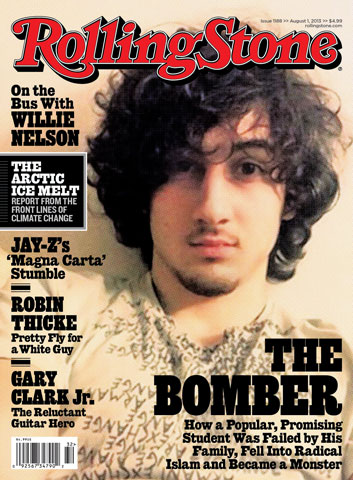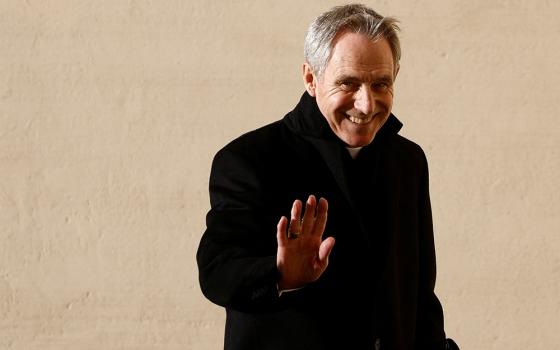
Boston Marathon bombing suspect Dzhokhar Tsarnaev appears on the cover of the Aug. 1 issue of Rolling Stone. (AP/Wenner Media)
Rolling Stone magazine's decision to put the face of accused Boston Marathon bomber Dzhokhar Tsarnaev on its Aug. 1 cover resulted in widespread anger from many quarters. Boston Mayor Thomas Menino called the cover photo "a disgrace" and told the magazine's editor that it "rewards a terrorist with celebrity treatment." Richard Donahue, the transit police office injured during a shootout with the bombing suspects, called the magazine's decision "thoughtless at best." Katlyn Townsend, a close friend of a marathon bombing victim who lost both legs, wrote, "Your use of a provocative, borderline sympathetic image and headline of someone who has caused so much pain to our country is appalling, insensitive, and disgusting." "Karate Kid" star Ralph Macchio tweeted: "Making a great album isn't enough to get you on the cover of rolling stone anymore. Blowing up kids is." Jack Osbourne, son of rock musician Ozzy Osbourne, called the decision "disgusting." He urged a boycott of the magazine. Several retailers, including 7-11, CVS, Stop & Shop and Walgreens, say they will refuse to sell the issue. If the outcry continues, Rolling Stone may lose advertisers as well.
As someone who heard and saw the bombs go off only minutes after crossing the Boston Marathon finish line with my son, I was and remain appalled at the indiscriminate cruelty of those attacks. All marathons, but especially Boston's, are innocent celebrations of what determined human beings can accomplish through hard work and the public affirmation lavished by enthusiastic spectators. Maiming and killing those people can never be justified.
But as an American who realizes that there is no way to secure the thousands of other public gatherings each week across the United States from future attacks, I want to learn as much as possible about why the Boston bombings occurred. If a neighbor breaks my window and I ask him why, I might learn that he was angry over something I can change, even something I ought to change.
Understanding the motivation of a terrorist in no way mitigates our condemnation of terrorism. The Tsarnaev cover in Rolling Stone includes the headline "THE BOMBER: How a Popular, Promising Student Was Failed by His Family, Fell Into Radical Islam and Became a Monster." The article by Janet Reitman is the product of two months' research and dozens of interviews. By presenting a nonthreatening, even flattering, photo of Tsarnaev on their cover, the editors of Rolling Stone underscore the point that it is not enough to say that people chose terrorism because they are "evildoers." All kinds of people, men and women, chose to kill other human beings for a wide variety of reasons. They do not start their lives as murderers. Something happens to convince them that killing is acceptable, even commendable. In many cases, grievous injustice, unaddressed or ignored, can lead people to violence. Political oppression, war, poverty, intolerance, bigotry, discrimination, sexism, abuse and mental illness might also be at the root. If we can remove or at least ameliorate some of these causes, it is in our self-interest to do so, but we need to know what they are first. Articles like Reitman's may serve that purpose.
As a Christian, though, I see the criticism of the Rolling Stone cover differently. A number of people have said that the photo elevated Tsarnaev, even glamorized him, when he deserved nothing but vilification. Another Osbourne, Kelly, accused Rolling Stone of "glorifying a monster." Nothing short of devil's horns would satisfy many who still seethe with rage over the bombings.
But Christians do not believe any human being is a demon. We are taught that God created all of us in God's image with a desire that we each become saints. We are also taught that no matter how often we sin, God is eager to forgive us, even counsels to imitate him/her by forgiving others 70 times seven times and loving our enemies. When confronted with an Adolf Hitler, it is easy to reduce him to pure evil, but it is theologically incorrect. The only difference between Judas Iscariot and St. Peter is that Peter did not despair of God's mercy. They both betrayed Christ. So did St. Paul, for that matter. Ours has never been a church of spotless saints. We are all broken in one way or another. No one would ever get to heaven on their merits alone.
Alexander Solzhenitsyn in The Gulag Archipelago, 1918-1956, describes how he was given a chance to become a prisoner/guard called a "blue cap." He accepted the post, hoping to be more merciful than the other guards, but quickly found himself taking on their cruelty, so he resigned.
Later on, Solzhenitsyn writes, "If only it were all so simple! If only there were evil people somewhere insidiously committing evil deeds, and it were necessary only to separate them from the rest of us and destroy them. But the line dividing good and evil cuts through the heart of every human being. And who is willing to destroy a piece of his own heart?"
Tsarnaev may be convicted of carrying out a monstrous act, but he must never be seen as a monster. Thinking like that is what enables people to commit acts like the marathon bombing. If we can always remember that our enemies are in fact our brothers, sisters, sons, daughters, mothers and fathers, we will work harder to find ways to overcome injustice and build peace.
When the Aug. 1 Rolling Stone comes out, I, for one, will buy a copy.
[Scott Schaeffer-Duffy is a member of the Sts. Francis & Therese Catholic Worker community in Worcester, Mass.]



